A Paired Alliance
Ninety percent of all bird species form breeding pairs that consist of just one male and one female. This is known as monogamy (monus meaning one and gamous meaning marriage). Birds have to catch food and feed their chicks directly as they have no internal source of nourishment like the mammary glands of mammals.
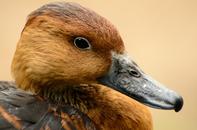
This is time-consuming and costs energy. By forming a paired alliance, both sexes invest equal time and energy into the relationship and parental duties and are subsequently able to rear offspring more successfully than should one bird be left to do so on its own.
The monogamous male bird must defend a territory full of resource and sing and display attractively to convince a female mate that he is the best candidate to care for her and her offspring. Once he has acquired a partner, a male will guard and attend to his female partner attentively to ensure paternity in return for his faithfulness.
The pair defends the territory together and spends much time maintaining the bond between them through allopreening, nuptial gifting, song and ritualized displaying. Comparatively, in polygamous birds (i.e. birds with many mates) most of a male’s energy is directed into the process of continuously attracting and mating with different partners.
Some Pair for Life
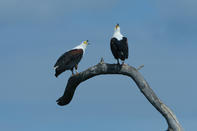
Pairing may happen once off as in the case of African Fish Eagles, Saddle-billed Storks and various ducks and geese, which pair for life or it may occur seasonally as in the case of migratory birds, which only have short periods in which to complete the breeding cycle.
Owls change their partners annually. Monogamous birds do not exhibit a great degree of sexual dimorphism, physical differences between the male and female sexes, as the emphasis is not so much on being attractive to mates, as in more colourful or dimorphic species, but rather on maintaining the pair bond and raising young.
Because both sexes are intimately involved in the nesting process, they need to be equally inconspicuous. Egyptian geese, doves, ducks and storks are good examples of birds with little to no sexual dimorphism, also called sexual monomorphism.
Reverse sexual dimorphism occurs in raptors where the female is the larger of the sexes, because of her role in producing and incubating eggs. The male is smaller so that he is more agile to capture prey to provide for his partner and brood.
Courtship
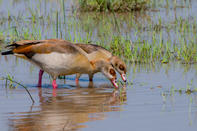
Egyptian geese are noisy birds which are conspicuous for their courtship and pairing activities, which involve chasing flights, jump flights (takes off and lands immediately) and affectionate allopreening (mutual preening).
They are extremely successful breeders and outside of the breeding season, they congregate gregariously in great numbers near water. Aside from the dual effort of the monogamous parents to care for the offspring, the reason they are so successful is their generalist approach to nesting sites.
Egyptian geese are not fussy about where they nest and they use a multitude of sites including the ground, holes, cliffs, disused hamerkop, heron, raptor and crow’s nests and even buildings. The location is lined with down to provide bedding for the eggs, which are also covered with down when the female is not in attendance.
The chicks are exceptionally precocial (well developed, feathered and eyes open at hatching). They will leave the nest within six hours of hatching literally responding to the summons of the mother goose by jumping out of their nest even if it is positioned meters above the ground.
The female will lead her brood to water where she and her male partner care for and protect the chicks. Doves spend a large amount of time reinforcing their pair bonds and declaring shared territory through calling. The work-hard-er, work-hard-er of the Cape Turtle Dove, the descending doo-doo-do-do-do-do of the Emerald Spotted Wood Dove and the chuckles of the Laughing Dove are all familiar, daily sounds in the bushveld.
Polygamous Birds
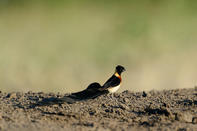
Species that do not practice monogamy are called polygamous (poly meaning many and gamous meaning marriage). Birds such as whydahs and weavers are generally polygamous and both groups invest a great deal of time and energy into the attraction phase of breeding.
They must convince females that they are worth choosing as mates irrespective of the fact that after mating they will abandon the females leaving them to take care of the offspring alone. The paradise whydah grows a long impressive tail and develops stunning plumage, which it shows off in display flights as an exhibition of gene superiority.
The whydahs subscribe to the theory known as ‘the handicap hypothesis’, which states that having an impressive tail is essentially a handicap, and if they are still able to outsmart predators with these impediments, then they are to be considered genetically fit by females.
Some of the weavers build homes to impress females into mating with them. At least half the preparation for chicks is thus completed before the male moves onto another mate leaving the female to care for and raise the chicks.
Polygyny and Polyandry
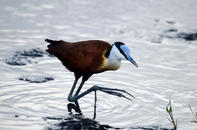
Polygamy, where the male has more than one mate, is called polygyny (poly meaning many and gyna meaning woman). Polygamy, where the female has more than one mate, is called polyandry (poly meaning many and andry meaning man) and this is practised by African jacanas and painted snipe.
The red-crested korhaan is a polygynous species and to attract females, the usually well-concealed male puts on an exhibition for the ladies rivalled by none. The bird starts with guttural clicking sounds, which then develop into well-paced whistled notes that gradually become louder and more urgent turning into a piping ‘pippity’ note.
He then takes off from the ground and flies diagonally up into the sky to just above the skyline where he stalls – folding his wings and flashing his black underbelly upwards – before dropping out of the sky like a half-brick. Just before the imminent crash landing, the male korhaan opens his wings and lands gracefully.
Popping to Attract a Female
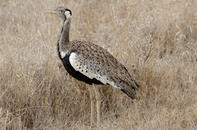
The black-bellied bustard also polygynous, is not as exhibitionistic as its relative the red-crested korhaan but relies on an equally novel tactic to impress females and denote territory.
The black-bellied bustard produces a guttural ‘quark’ sound from within his erect but bloated neck that shows off the black and white throat and then quickly retracts the neck into the shoulders before stretching it straight up again and emanating a ‘pop’. The overall effect resembles the uncorking of a champagne bottle.
By Megan Emmett